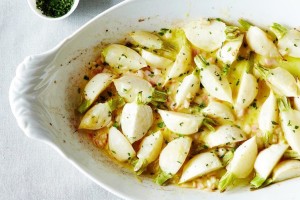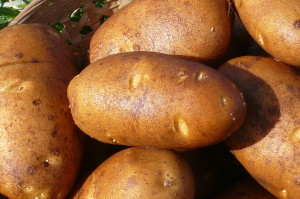Standard Box
Lettuce, 1 hd
Red Beets with Green, 1 bu
Red Cabbage, 1 hd
Baby White Turnips, 1 bu
Cauliflower, 1 hd
Rainbow Chard, 1 bu
Lacinato Kale, 1 bu|
Walla Walla Onion
Curly Parsley, 1 bu
Russet Potatoes, 1 lbs
Spinach, 1 bu
Small Box
Lettuce, 1 hd
Apples, 1.5 lbs
Golden Beets with Greens, 1 bu
Baby White Turnips, 1 bu
Juice Carrots, 3 lbs
Red Chard, 1 bu
Green Kale, 1 bu
Russet Potatoes, 1 lbs
Baby White Turnips
Turnips are very low-calorie root vegetables, with just 28 calories per 100 g, plus they are a very good source of antioxidants, minerals, vitamins (especially C) and dietary fiber. These nutrients boost the immune system, helping the body scavenge harmful free radicals and prevent cancers and inflammation.
Turnip greens are also a storehouse of many vital nutrients, containing several times more than the levels in the roots. They are a good source of vitamins and antioxidants, such as vitamin A, B complex, C, K, carotenoid, xanthin, and lutein, as well as the minerals calcium, copper, iron, potassium, and manganese.
Turnips are very versatile:
- Young turnips are one of the favored items in raw salads for their sweet taste, complementing cabbage, parsnips, carrots, beets, etc.
- They mix well with other vegetables like kohlrabi, potato, and carrots in stews.
- Diced sautéed turnips are delicious with poultry, lamb, and pork.
- Mix raw baby turnip slices with olives and cherry tomatoes in olive oil and balsamic vinegar for an appetizer.
- Turnip cubes are great pickled.
- Turnip greens are used with other greens and vegetables in soups, curries, and stews.
- Like all root veggies, turnips are fantastic roasted.
Roasted Baby Turnips
1 bunch baby turnips, peeled and chopped into quarters
1 Tbsp. olive oil
Salt and pepper to taste
Preheat oven to 400° F. Toss baby turnips in olive oil and salt. Spread in a single layer on a baking sheet. Roast for 10 to 15 minutes, or until soft on the inside, with a slightly caramelized exterior.
Dijon-Shallot Vinaigrette
1 Tbsp. white wine vinegar
1/2 Tbsp. Dijon mustard
2 Tbsp. extra-virgin olive oil
1 small shallot, finely minced
Pinch of salt, to taste
1/2 Tbsp. finely sliced fresh tarragon
While turnips are roasting, whisk together the white wine vinegar and Dijon mustard. Slowly whisk in the olive oil, taking care not to add too much at a time. Whisk until emulsified, then whisk in the shallots, salt and tarragon. Toss in the roasted turnips. This is best served at room temperature.
We thank www.food52.com for this recipe.
Russet Potatoes
Potatoes are indigenous to South America. Spanish explorers brought them to Europe, where they were cultivated and brought back across the Atlantic with the colonists. At first, settlers used potatoes for animal feed. The unpredictable shape and somewhat bland taste made them generally disliked. That changed when Massachusetts horticulturist Luther Burbank created the hybrid today recognized as the standard Russet potato.
Burbank began crossbreeding potato plants in the mid-1800s, convinced that he could make a crop that was easy to grow and palatable. The Russet Burbank hit both of these goals, and also proved to be very disease- resistant. Pioneers who traveled west across the United States brought seedlings of Burbank’s plants with them.
Today, the Russet is the most popular potato in the United States, because it has firm flesh and a long shape, making it ideal for French fries. It lends itself well to being boiled, baked, fried, steamed, or roasted, with or without the peel. Sure, Russets are great with butter and sour cream, but try one with a just olive oil and Balsamic vinegar. You get its vitamins C and B6, plus protein and fiber, without the added calories.


